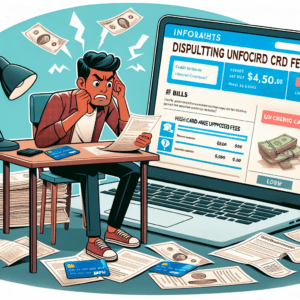“Uncover Hidden Credit Card Fees – Stop Losing Hundreds Every Year!”
**Unexpected Foreign Transaction Fees: How They Add Up and How to Avoid Them**
Many credit card users are unaware of the hidden fees that can accumulate over time, significantly increasing the cost of using their cards. One such fee that often goes unnoticed is the foreign transaction fee. While it may seem like a minor charge, these fees can quickly add up, especially for those who frequently travel abroad or make purchases from international merchants. Understanding how these fees work and taking steps to avoid them can help cardholders save hundreds of dollars each year.
Foreign transaction fees are typically charged when a purchase is made in a currency other than the cardholder’s home currency or when a transaction is processed through a foreign bank. These fees generally range from 1% to 3% of the total transaction amount, depending on the credit card issuer. While this percentage may seem small, frequent international purchases can lead to substantial additional costs over time. For example, if a traveler spends $5,000 on a trip abroad and their credit card imposes a 3% foreign transaction fee, they would incur an extra $150 in fees alone. This expense is often overlooked until it appears on the monthly statement, catching many cardholders by surprise.
Moreover, foreign transaction fees are not limited to in-person purchases made while traveling. Many online shoppers unknowingly pay these fees when buying from international retailers. Even if a website appears to be in the cardholder’s local language and displays prices in their home currency, the payment may still be processed through a foreign bank, triggering the fee. This can be particularly frustrating for consumers who frequently shop online, as they may not realize they are incurring additional charges with each purchase.
To avoid these unexpected costs, cardholders should consider using credit cards that do not charge foreign transaction fees. Many financial institutions offer travel-friendly credit cards specifically designed to eliminate these charges, making them an excellent choice for frequent travelers and online shoppers alike. Before applying for a new card, it is essential to review the terms and conditions to ensure that foreign transaction fees are not included. Additionally, some premium credit cards that offer travel rewards and other benefits often waive these fees as part of their perks. While these cards may come with an annual fee, the savings on foreign transaction fees alone can often justify the cost.
Another effective strategy is to use alternative payment methods when making international purchases. Digital payment platforms such as PayPal or certain mobile wallets may offer more favorable exchange rates and lower fees compared to traditional credit cards. Additionally, some banks provide multi-currency accounts that allow users to hold and spend money in different currencies without incurring conversion fees. By exploring these options, consumers can minimize unnecessary expenses and make more cost-effective purchasing decisions.
Ultimately, being aware of foreign transaction fees and taking proactive steps to avoid them can lead to significant savings. Whether by choosing a credit card that does not impose these charges or by utilizing alternative payment methods, consumers can protect themselves from unexpected costs. By staying informed and making strategic financial choices, cardholders can ensure that they are not paying more than necessary for their international transactions.
**Sneaky Annual Fees: Are You Paying More Than You Should?**

Credit cards can be a convenient financial tool, offering rewards, cashback, and the ability to manage expenses efficiently. However, many cardholders may not realize that hidden fees can significantly impact their finances. Among these, annual fees are one of the most common yet often overlooked charges. While some credit cards advertise attractive benefits, the cost of maintaining them may outweigh the advantages. Understanding how these fees work and whether they are justified is essential to ensuring that you are not paying more than necessary.
Many credit card issuers charge an annual fee in exchange for premium benefits such as travel rewards, concierge services, or higher cashback rates. While these perks may seem appealing, the cost of maintaining the card can sometimes exceed the value of the rewards earned. For instance, a card with a $95 annual fee may offer travel credits or bonus points, but if you do not use these benefits frequently, you may end up paying for services you do not fully utilize. In such cases, it is important to evaluate whether the rewards justify the expense or if a no-annual-fee alternative would be a better option.
Additionally, some credit cards waive the annual fee for the first year, only to charge a substantial amount in subsequent years. This strategy can make a card seem more affordable initially, but once the fee is applied, it may come as an unwelcome surprise. Cardholders who sign up for a credit card based on an introductory offer should carefully review the terms and conditions to understand when the fee will be charged and whether it aligns with their long-term financial goals. If the benefits do not outweigh the cost, it may be wise to consider switching to a different card before the fee is applied.
Another factor to consider is whether you are unknowingly paying for multiple credit cards with annual fees. Some consumers hold several cards, each with its own set of benefits, but fail to assess whether they are truly maximizing their value. If you have multiple cards with annual fees, it may be beneficial to consolidate your spending onto one or two cards that offer the most relevant rewards while eliminating those that provide little value. This approach can help reduce unnecessary expenses while still allowing you to take advantage of credit card perks.
Furthermore, some credit card issuers allow customers to request a fee waiver or downgrade to a no-annual-fee version of the card. If you find that the annual fee is not justifiable, contacting your credit card provider to negotiate a waiver or explore alternative options may be worthwhile. In some cases, issuers may offer a retention bonus or other incentives to keep you as a customer, which can help offset the cost of the fee.
Ultimately, being aware of sneaky annual fees and assessing whether they align with your spending habits is crucial to managing your finances effectively. By carefully reviewing your credit card statements, comparing available options, and considering whether the benefits outweigh the costs, you can avoid unnecessary expenses and ensure that you are not paying more than you should. Taking the time to evaluate your credit card choices can lead to significant savings and a more financially sound approach to credit management.
**Hidden Interest Charges: The Cost of Not Understanding Your Billing Cycle**
Many credit card users assume that as long as they make their minimum payments on time, they are managing their accounts responsibly. However, a lack of understanding about how billing cycles work can lead to hidden interest charges that quietly accumulate over time. These charges may seem insignificant at first, but they can add up to hundreds of dollars each year, making it essential for cardholders to fully grasp how their credit card issuer calculates interest.
One of the most common misconceptions is that interest is only charged on balances that remain unpaid after the due date. While this is generally true for purchases, many cardholders do not realize that the timing of their payments within the billing cycle can also impact the amount of interest they owe. Credit card companies typically use an average daily balance method to calculate interest, meaning that even if a payment is made before the due date, interest may still accrue on the balance carried throughout the billing period. This can be particularly costly for those who make large purchases early in the cycle and only pay a portion of the balance before the statement closes.
Furthermore, many consumers are unaware of how grace periods work. A grace period is the time between the end of a billing cycle and the payment due date, during which no interest is charged on new purchases—provided the previous statement balance was paid in full. However, if a cardholder carries a balance from one month to the next, the grace period is typically forfeited, and interest begins accruing on new purchases immediately. This means that even if a person pays off a significant portion of their balance, they may still be subject to interest charges on new transactions, leading to an ongoing cycle of debt accumulation.
Another factor that contributes to hidden interest charges is the way credit card issuers apply payments. Many consumers assume that their payments go directly toward the most expensive debt first, such as cash advances or high-interest purchases. However, while the Credit Card Accountability Responsibility and Disclosure (CARD) Act of 2009 requires issuers to apply amounts above the minimum payment to the highest-interest balance, the minimum payment itself is often applied to lower-interest balances first. This means that if a cardholder has multiple types of transactions on their account—such as purchases, balance transfers, and cash advances—interest may continue to accrue on the higher-interest portions of their balance even as they make regular payments.
To avoid these hidden interest charges, it is crucial for consumers to familiarize themselves with their credit card’s terms and conditions. Understanding how billing cycles work, when grace periods apply, and how payments are allocated can help cardholders make more informed financial decisions. Paying off the full statement balance each month is the most effective way to avoid interest charges altogether. Additionally, making payments earlier in the billing cycle rather than waiting until the due date can help reduce the average daily balance, ultimately lowering the amount of interest accrued.
By taking the time to understand these often-overlooked details, credit card users can prevent unnecessary interest charges and save themselves hundreds of dollars each year. A proactive approach to managing credit can make a significant difference in long-term financial health, ensuring that consumers retain more of their hard-earned money rather than losing it to hidden fees.
















